Intel NUC10i7FNH Frost Canyon Review: Hexa-Core NUC Delivers a Mixed Bag
by Ganesh T S on March 2, 2020 9:00 AM ESTBAPCo SYSmark 2018
The Intel NUC10i7FNH (Frost Canyon) was evaluated using our Fall 2018 test suite for small-form factor PCs. In the first section, we will be looking at SYSmark 2018.
BAPCo's SYSmark 2018 is an application-based benchmark that uses real-world applications to replay usage patterns of business users in the areas of productivity, creativity, and responsiveness. The 'Productivity Scenario' covers office-centric activities including word processing, spreadsheet usage, financial analysis, software development, application installation, file compression, and e-mail management. The 'Creativity Scenario' represents media-centric activities such as digital photo processing, AI and ML for face recognition in photos and videos for the purpose of content creation, etc. The 'Responsiveness Scenario' evaluates the ability of the system to react in a quick manner to user inputs in areas such as application and file launches, web browsing, and multi-tasking.
Scores are meant to be compared against a reference desktop (the SYSmark 2018 calibration system, a Dell Optiplex 5050 tower with a Core i3-7100 and 4GB of DDR4-2133 memory to go with a 128GB M.2 SATA III SSD). The calibration system scores 1000 in each of the scenarios. A score of, say, 2000, would imply that the system under test is twice as fast as the reference system.
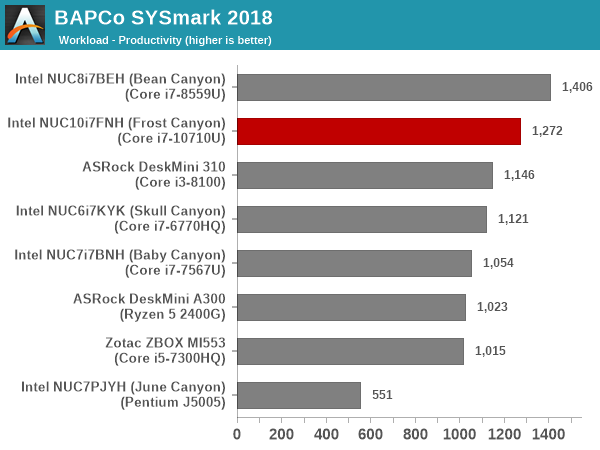
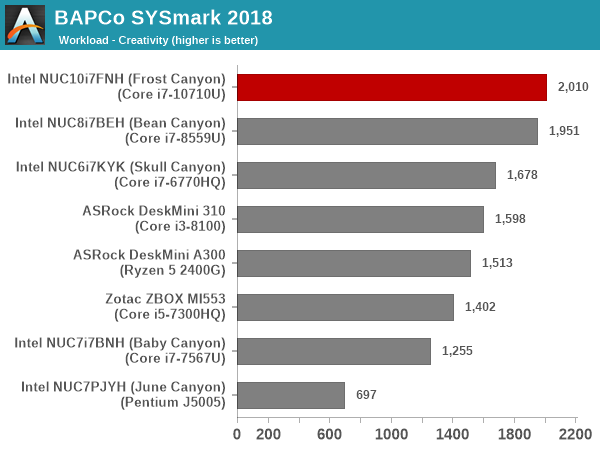
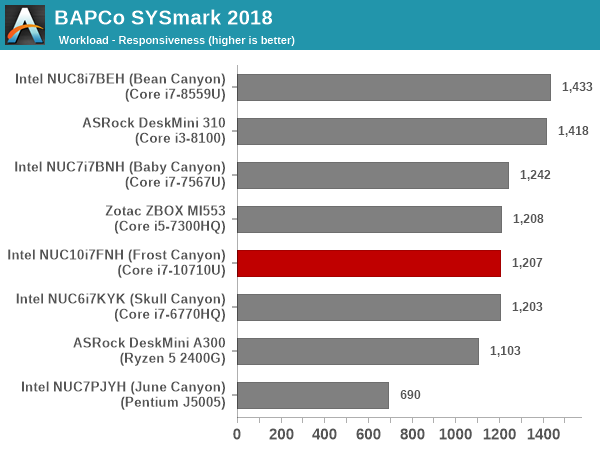
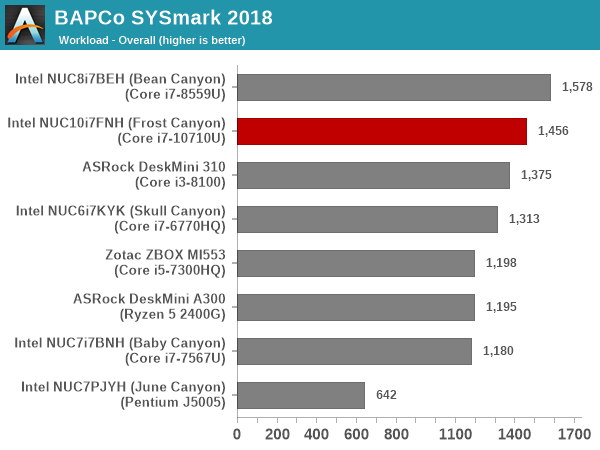
SYSmark 2018 also adds energy measurement to the mix. A high score in the SYSmark benchmarks might be nice to have, but, potential customers also need to determine the balance between power consumption and the efficiency of the system. For example, in the average office scenario, it might not be worth purchasing a noisy and power-hungry PC just because it ends up with a 2000 score in the SYSmark 2014 SE benchmarks. In order to provide a balanced perspective, SYSmark 2018 also allows vendors and decision makers to track the energy consumption during each workload. In the graphs below, we find the total energy consumed by the PC under test for a single iteration of each SYSmark 2018 workload. For reference, the calibration system consumes 5.36 Wh for productivity, 7.71 Wh for creativity, 5.61 Wh for responsiveness, and 18.68 Wh overall.
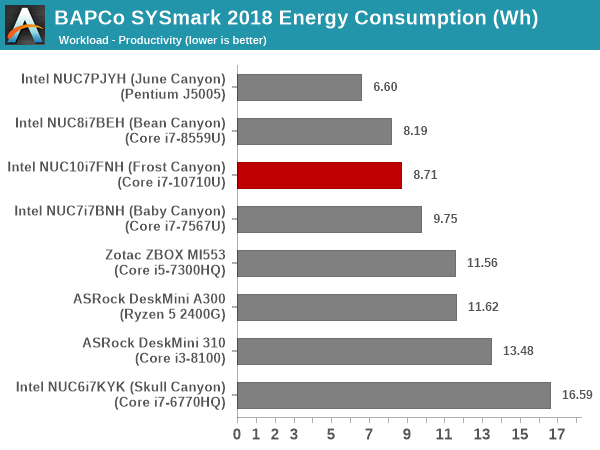
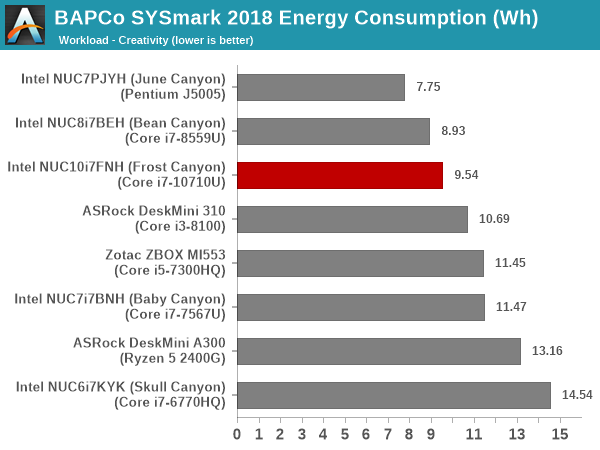
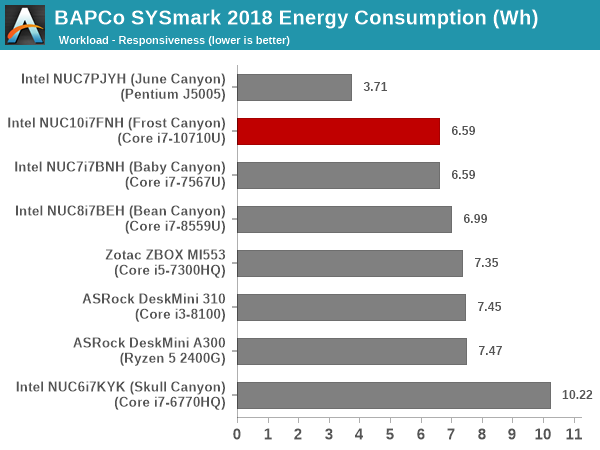
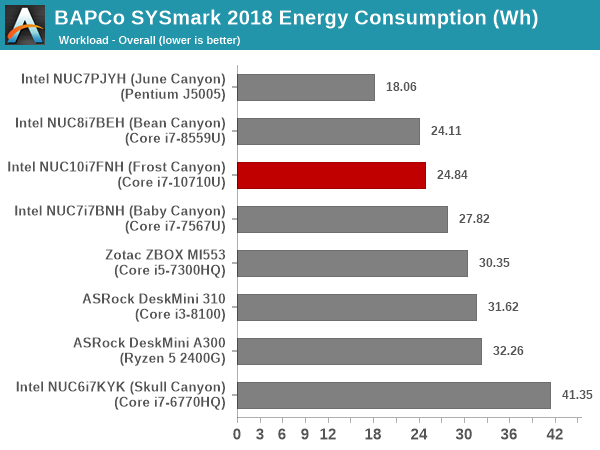
The 'Creativity' workload benefits from the extra cores in Frost Canyon compared to the Core i7-8559U in the Bean Canyon. Our Bean Canyon review configuration is also equipped with a WD Black 3D NVMe SSD (PCIe 3.0 x4) that delivers much better performance compared to the PCIe 3.0 x2 Kingston A1000-class in the Frost Canyon configuration. This results in the responsiveness score for the NUC10i7FNH coming in the middle of the pack compared to the other systems in the sample set. This pulls down the Frost Canyon NUC well below the Bean Canyon NUC in the overall score. The energy consumption is also worse off.










85 Comments
View All Comments
yankeeDDL - Monday, March 2, 2020 - link
I don't think anyone is arguing that high-end graphics is needed in NUC. The iGPU of a 2400G, or that of a 4800U are definitely *not* high-end graphics. UHD is a sore thumb on pretty much anything that is not office and email.Rookierookie - Monday, March 2, 2020 - link
Office and email are exactly what most people would buy this for. UHD even has competent video playback.yankeeDDL - Tuesday, March 3, 2020 - link
What? 1Kusd for a PC for office and email? You can buy a good laptop for that price, and get the screen and the portability. No, at least not only office and email. I, for one, have been looking at NUCs to use as a light gaming machine, video/Youtube player to be connected to my TV. I've been looking at Zotac's products, to give you an idea: a "NUC" with a Ryzen 4800H should blow this out of the water, both in CPU and GPU performance, while probably being quite a bit cheaper.Samus - Monday, March 2, 2020 - link
Nearly 90% of all PC's sold (desktops, laptops, PC, MAC, etc) rely on Intel iGPU's and the UI's their OS's run must be built around their limitations.You need to consider Intel has been indirectly holding back UI progress and developement for two decades while everyone around them (from AMD to SoC chipmakers) has been focusing on GPU performance. It could be argued
A) Intel couldn't be taken seriously in the ultramobile SoC space because they don't have a GPU to backup their APU\FPU IP and advanced production capabilities, which is why they threw in the towel.
B) Intel is responsible for the collapse of the PC market (the death of the PC as they call it) because they have halted evolutionary progress on the UI experience, meanwhile mobile devices have vastly outpaced PC's due to their superior graphics performance, and thus UI's.
C) Intel is embarrassingly the ONLY chipmaker struggling with GPU development. Because of their blind devotion to margins and profits, they have refused to license IP from companies that actually know what the fuck they are doing, meanwhile seemingly unable to engineer a product that's even close to competitive with the markets slowest options.
khanikun - Monday, March 2, 2020 - link
B) Huh? What was halted for the UI experience, due to graphics? Rounded corners in Windows? Translucent windows? If anything, MS is the ones ruining the UI experience with Win 8, Win 10, and the current garbage Start Menu.If all you're looking at is eye candy, check out today's Windows, Android, iOS. They're all flattening out the UI. Shit's literally Win 95 with more color options.
Lord of the Bored - Thursday, March 5, 2020 - link
"current garbage Start Menu"As opposed to the old garbage start menu.
The Start menu has always been terrible. Back in 1995 AD, it was actually worse than Program Manager, and it hasn't actually improved a lot since then. (Windows 95 made several other changes that were very welcome, like the one-touch close button and always-accessible task bar. The start menu is notable for how uniquely bad it is in an overhaul otherwise full of good ideas.)
Just because you are used to it doesn't make it right.
(And the Windows 10 interface is not Win 95 with more colors. It is a flatter and less complex Win 95 with FEWER colors. Nary a 3D bevel in sight.)
Foeketijn - Tuesday, March 3, 2020 - link
Then buy a SimplyNUC’s Sequoia. I like that I sold dozens of the things, and the only complaint is HDMI not coming on after sleep state once in a while, and 1 broken after a lightning incident.So they are in general bullet proof. Nobody once even asked about the GPU. And I am typing this using an old NUC on a 4k screen combined with a 1440p screen. No gaming, no Autocad and everything is well.
AbRASiON - Tuesday, March 3, 2020 - link
Interesting, some of us /couldn't possibly care less/ about the graphics, as long as it's enough to run Windows reliably and play back video. But we would like more and more CPU performance in a low sized form factor.nico_mach - Monday, March 2, 2020 - link
You ... took a delivered, complete system apart to review it? And it's the first assembled NUC ever offered? Well, that's bold.BedfordTim - Monday, March 2, 2020 - link
The used to make complete Atom based NUCs which were pretty good value.